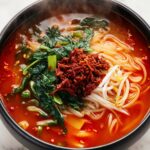Description
This Korean Spicy Beef Vegetable Soup features tender beef brisket simmered in a flavorful homemade broth with a variety of vegetables and a spicy chili oil made from Korean chili flakes and sesame oil. The soup is infused with traditional Korean seasonings like gochujang, soy sauce, and anchovy sauce, delivering a harmonious balance of spicy, savory, and umami flavors. Perfect for a comforting meal that highlights authentic Korean tastes.
Ingredients
Scale
Dried Vegetables
- 0.8 oz (22g) dried fernbrake
- 1 oz (28g) dried taro stem (optional)
Fresh Vegetables
- 8 oz (225g) mung bean sprouts
- 5 oz (140g) oyster mushrooms (or shiitake), torn into bite-size pieces
- 2 Asian leeks
- 1 large onion, cut in half
- 1 whole garlic, cut in half
- 3 cloves garlic, minced
- 1/2 lb (225g) Korean radish, cut into large chunks
Meat
- 1 1/4 lb (560g) beef brisket
Seasonings & Sauces
- 1 teaspoon Korean chili paste (gochujang)
- 1 tablespoon soy sauce
- 3 tablespoons Korean soup soy sauce (gukganjang)
- 1 1/2 tablespoons Korean anchovy sauce
- Salt and pepper, to taste
- 3-4 tablespoons Korean chili flakes (gochugaru)
Oils
- 2 tablespoons oil
- 2 tablespoons sesame oil
Liquids
- 14 cups (about 3 liters) water
Instructions
- Rehydrate Dried Vegetables: Boil the dried fernbrake and taro stem separately until they are softened. After boiling, soak them for 1 hour to fully rehydrate. Drain, rinse under cold water, and slice the vegetables into manageable pieces.
- Make Beef Stock: In a large stockpot, combine the onion halves, whole garlic halves, Korean radish chunks, and beef brisket with 14 cups (about 3 liters) of water. Bring this mixture to a boil over high heat, then reduce heat to low and simmer gently for 45 minutes to develop a rich, flavorful stock.
- Strain Stock and Prepare Beef: After simmering, discard the vegetables from the pot. Remove the beef brisket and shred it into bite-sized pieces. Strain the stock to remove any solids and keep it reserved for later use.
- Blanch Fresh Vegetables: Prepare the Asian leeks by cleaning and cutting them as desired. Bring a pot of salted boiling water and blanch mung bean sprouts, mushrooms, and leeks for a few seconds until slightly softened but still crisp. Drain the vegetables and rinse under cold water to stop cooking, then squeeze out any excess water.
- Make Chili Oil: In a separate pot or saucepan, heat the oil and sesame oil over low heat. Add the Korean chili flakes (gochugaru) and stir constantly for about 30 seconds to infuse the oil with a spicy, smoky flavor without burning the flakes.
- Combine and Simmer Soup: Add the blanched vegetables and shredded beef to the pot with the chili oil. Pour in the reserved beef stock and stir to combine. Add the Korean chili paste (gochujang) and bring the soup to a gentle simmer. Cook for 15-20 minutes to allow all the flavors to meld.
- Season Soup: Finish by seasoning the soup with soy sauce, Korean soup soy sauce (gukganjang), and Korean anchovy sauce. Adjust salt and pepper to your taste. Stir well and serve hot for a comforting and spicy Korean beef vegetable soup experience.
Notes
- Soaking and boiling the dried vegetables separately helps remove any earthy bitterness and ensures they soften evenly.
- Using both soy sauce and gukganjang (Korean soup soy sauce) adds depth of flavor and a balanced saltiness.
- Adjust the amount of Korean chili flakes (gochugaru) and chili paste (gochujang) to control the spiciness level.
- Beef brisket is preferred for its tenderness and rich flavor after slow simmering.
- If dried taro stem is unavailable, you may omit it or substitute with other dried vegetables like dried fiddleheads.

